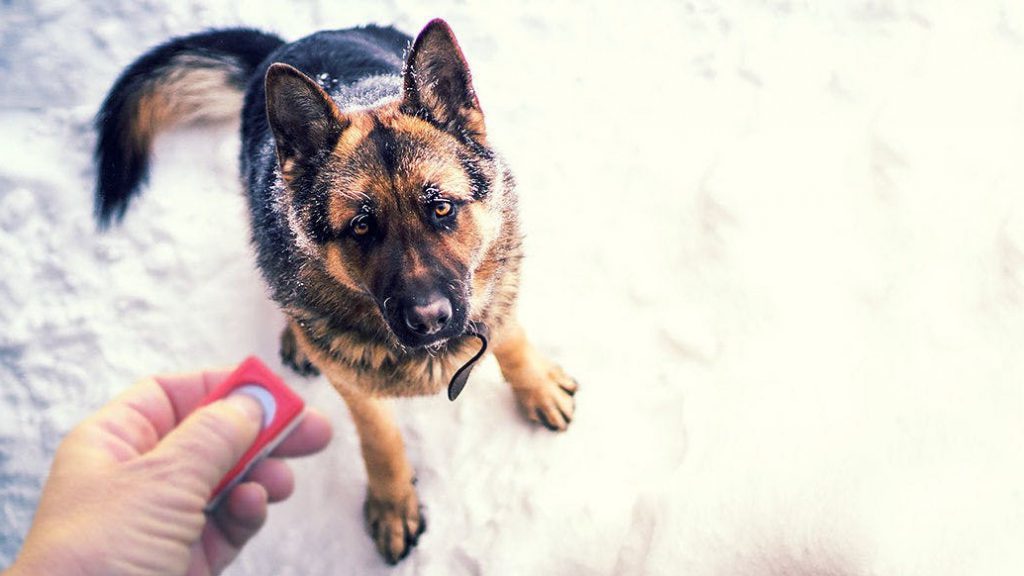Training German Shepherd’s (with a Clicker)
German Shepherds are intelligent dogs, and this makes training them easier as they can be taught behaviors easily. They respond well to almost any type of dog obedience training whether you use clicker training to teach commands, or other reward methods that may be more suitable to the time and effort you want to put in. Here are a few tips to help you with the training of your German Shepherd puppy, whether you want your dog training to be about agility, simple commands, or training him to guard your home
Clicker Training

Clicker training is a method of training your dog that encourages him to associate the sound of a clicker with his reward. It is a great method for German shepherd dog training because the breed is so quick to pick up new behavior. The way it works is that when you teach a new behavior or agility trick, you use a clicker as an audible approval sound that is followed immediately by a reward (usually praise or a treat). The reasoning is that the clicker gives the instant approval to bridge the time between the behavior and the production of the reward.
Clicker training can start as young as 10 weeks, the younger you start the shorter the sessions should be, as younger puppies have less patience and it is important to avoid frustration.
Once the dog understands that he is going to be rewarded he is ready to start learning new behaviors.
How Clickers Work
A clicker is a small plastic or metal device with a button on it. When you press that button, it creates a sharp clicking sound. The human ear can pick it up easily, which means it will be very distinct to a dog’s far more acute sense of hearing.
When you use a clicker, you relay a single sharp piece of feedback to your dog – something so simple that they can clearly understand it. Basically, after some initial training, German Sheperd’s learn quickly that the clicker means “perform this act for praise”.
Once you’ve taught him that the sound of the clicker means praise or treats are coming, he will work hard to identify the command you’re giving and respond to it.
Dogs are conditioned to perform certain actions, this idea is very simple. Humans can think through a process and recognize benefits of performing further down the road. A dog cannot. A dog needs immediate feedback telling them that sitting when you say “sit” is good. A clicker provides that instant conditioning feedback
Training German Shepherd’s with Your Clicker
You need to train your German Shepherd to recognize the sound of the clicker as a sign of positive feedback to start with. This is classical conditioning – when you combine two seemingly unrelated things to get an action.
In this case, you will use the clicker and then give your dog a treat. For each German Shepherd, the amount of time it takes to make the connection varies. In my experience, though, they figure it out pretty fast – usually in no more than an hour over the course of a day or two.
Once your dog knows that the clicker means “reward!” they will immediately respond when they hear it. So, now you need to get your dog to perform the action you’re aiming for. You can lure him, help him, or coax him – whatever is necessary to make him sit, lie down, or speak. Sometimes, he will do it naturally.
Training your German Shepherd gets far easier at this point. Whenever he performs the action you’re targeting, you will click your clicker and then reinforce his behavior with a treat or reward.
Once your dog recognizes the behavior they are supposed to perform, you can start generalizing it by having him perform it in different places, for different lengths of time or further away from you.
Finally, add a command to the process and teach your dog to follow a verbal cue – in this case “sit” or “speak”. Over the course of a few days, he should be able to perform the trick without needing to hear the clicker.
Remember to only do one command at a time. Training German Shepherds with more than one command at a time can be confusing. Don’t worry – he will remember. You’ve just planted a seed deep in his brain and it’s unlikely to dislodge anytime soon.